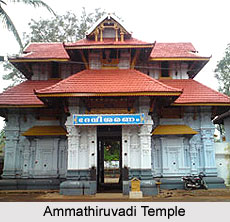 Ammathiruvadi Temple is a famous Hindu temple located about 12 km away from the city of Thrissur in the Indian state of Kerala. It is believed that the temple was founded by Poomulli Namboothiri also sometimes referred to as Thiruvalayannur Bhattathiri almost 700 to 1000 years ago. Earlier the place where the temple is located served as the household of Namboothiri. Urakam was then a part of the Peruvanam village that was one of the 64 villages of ancient Kerala. Devotees from far off places visit this temple to offer their worship to the goddess and receive her blessings.
Ammathiruvadi Temple is a famous Hindu temple located about 12 km away from the city of Thrissur in the Indian state of Kerala. It is believed that the temple was founded by Poomulli Namboothiri also sometimes referred to as Thiruvalayannur Bhattathiri almost 700 to 1000 years ago. Earlier the place where the temple is located served as the household of Namboothiri. Urakam was then a part of the Peruvanam village that was one of the 64 villages of ancient Kerala. Devotees from far off places visit this temple to offer their worship to the goddess and receive her blessings.
Legend of Ammathiruvadi Temple
Ammathiruvadi Temple is associated with many legends and folklores. According to a legend once Namboothiri went to Kanchipuram to visit the Kamakshi Amman Temple. There he revered and worshipped the deity with full devotion. The goddess, Kanchi Kamakshi was very satisfied with his devotion and decided to come to Kerala on his palm leaf umbrella. Namboothiri after reaching home placed the umbrella on the floor of his house. He then went away for some work. After he came back he tried to pull up the umbrella but could not. After investigating the matter he realised that the goddess was residing there. That night Namboothiri saw goddess Kamakshi in his dreams. The goddess instructed him to build a temple for her and leave Urakam. He was also told that he would find an idol in a well far away and should re-establish the goddess from the umbrella onto that idol. Namboothiri followed all the instructions of the goddess. The temple was built beautifully and handed over the administration to the Maharaja of Cochin. He also offered all the wealth that he possessed for the temple. From then on the goddess was known as the Ammathiruvadi and deeply worshipped by the devotees.
Architecture of Ammathiruvadi Temple
The Ammathiruvadi Temple has been built and designed beautifully. The temple is adorned with two imposing and lofty Gopurams i.e. ornamental gateways. It also has a Mathilkettu also known as compound wall, Ootupura i.e. dining hall, Naalambalam that has been built immediately surrounding the sanctum sanctorum. The temple has a double storied Sreekovil i.e. sanctum sanctorum.





















